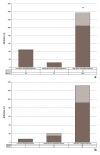Sport Sampling Is Associated With Improved Landing Technique in Youth Athletes
- PMID: 29131779
- PMCID: PMC5857728
- DOI: 10.1177/1941738117736056
Sport Sampling Is Associated With Improved Landing Technique in Youth Athletes
Abstract
Background: Sport sampling is recommended to promote fundamental movement skill acquisition and physical activity. In contrast, sport specialization is associated with musculoskeletal injury risk, burnout, and attrition from sport. There is limited evidence to support the influence of sport sampling on neuromuscular control, which is associated with injury risk, in youth athletes.
Hypothesis: Athletes who participated in only 1 sport during the previous year would demonstrate higher Landing Error Scoring System (LESS) scores than their counterparts.
Study design: Cross-sectional study.
Level of evidence: Level 3.
Methods: A total of 355 youth athletes (age range, 8-14 years) completed a test session with a jump-landing task, which was evaluated using the LESS. Participants were categorized as single sport (SS) or multisport (MS) based on their self-reported sport participation in the past year. Their duration of sport sampling (low, moderate, high) was determined based on their sport participation history. Participants were dichotomized into good (LESS <5) or poor (LESS ≥5) categories. Chi-square tests were performed to evaluate for the association between control category (good, poor) and participation (MS, SS), as well as sport-sampling duration (low, moderate, high).
Results: The MS group was 2.5 times (95% CI, 1.9-3.1) as likely to be categorized as having good control compared with the SS group (χ2(355) = 10.10, P < 0.01). Recreational participants in the "high" sport-sampling duration group were 5.8 times (95% CI, 3.1-8.5) and 5.4 times (95% CI, 4.0-6.8) as likely to be categorized as having good control compared with the moderate and low groups (χ2(216) = 11.20, P < 0.01).
Conclusion: Sport sampling at a young age is associated with improved neuromuscular control, which may reduce injury risk in youth athletes.
Clinical relevance: Youth athletes should be encouraged to try participating in multiple sports to enhance their neuromuscular control and promote long-term physical activity.
Keywords: injury risk; physical literacy; sport diversification; sport sampling; sport specialization.
Conflict of interest statement
The following author declared potential conflicts of interest: Steve Boyle is the founder of 241 Sports, LLC, a company to promote sport sampling and physical literacy. The authors acknowledge the Charles Hood Foundation for Child Health Research for providing financial support for this investigation.
Figures


References
-
- Bell DR, Post EG, Trigsted SM, Hetzel S, McGuine TA, Brooks MA. Prevalence of sport specialization in high school athletics: a 1-year observational study. Am J Sports Med. 2016;44:1469-1474. - PubMed
-
- Bergeron MF, Mountjoy M, Armstrong N, et al. International Olympic Committee consensus statement on youth athletic development. Br J Sports Med. 2015;49:843-851. - PubMed
-
- Brenner JS. American Academy of Pediatrics Council on Sports Medicine and Fitness. Overuse injuries, overtraining, and burnout in child and adolescent athletes. Pediatrics. 2007;119:1242-1245. - PubMed
MeSH terms
LinkOut - more resources
Full Text Sources
Other Literature Sources
Medical
Research Materials
Miscellaneous

